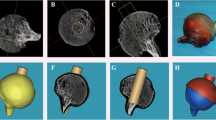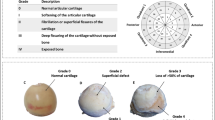Abstract
We have recently revealed significant differences in microarchitectural properties (i.e. global and local morphometries) and mechanical properties between rheumatoid arthritis (RA), osteoarthritis (OA) and osteoporosis (OP) in cancellous bones. This study compared these properties with those of ageing controls by matching bone volume fraction (BV/TV), the most important determinant for bones’ mechanical properties, to investigate whether these bones have similar properties and degenerative potentials. RA, OA and OP femoral heads were harvested from patients undergoing total hip replacement surgery. The selected patients were matched by similar cancellous bone BV/TV, with seven patients in each group. Four samples were prepared from each femoral head and scanned with micro-CT to quantify microarchitectural properties and compression tested to determine mechanical properties. In terms of global morphometry, no significant differences were observed between these diseased bones. In terms of local morphometry, the number of plates in the RA group was significantly greater than that of the OP and control groups. Plate volume density in the RA group was significantly greater than in the control group. Interestingly, the ultimate stresses in the three diseased groups were 77% to 195% lower than in the control group (p < 0.001). Degenerations of global morphometry of cancellous bones in these diseased femoral heads are similar but more severe than in ageing controls matched by BV/TV, as evidenced by pronounced reduction in bone strength. This phenomenon suggests that some local morphometric parameters, along with other factors, such as abnormal collagen, mineralisation, erosion and microdamage, may contribute to further compromising mechanical properties.

Similar content being viewed by others
References
Ding M, Overgaard S (2021) 3-D microarchitectural properties and rod- and plate-like trabecular morphometric properties of femur head cancellous bones in patients with rheumatoid arthritis, osteoarthritis, and osteoporosis. J Orthop Transl 28:159–168. https://doi.org/10.1016/j.jot.2021.02.002
Ding M (2010) Microarchitectural adaptations in aging and osteoarthrotic subchondral bone issues. Acta Orthop Suppl 81(340):1–53. https://doi.org/10.3109/17453671003619037
Stauber M, Muller R (2006) Volumetric spatial decomposition of trabecular bone into rods and plates–a new method for local bone morphometry. Bone 38(4):475–484
Stauber M, Rapillard L, van Lenthe GH, Zysset P, Muller R (2006) Importance of individual rods and plates in the assessment of bone quality and their contribution to bone stiffness. J Bone Miner Res 21(4):586–595. https://doi.org/10.1359/jbmr.060102
Ding M, Danielsen CC, Hvid I, Overgaard S (2012) Three-dimensional microarchitecture of adolescent cancellous bone. Bone 51(5):953–960. https://doi.org/10.1016/j.bone.2012.07.018
Odgaard A (1997) Three-dimensional methods for quantification of cancellous bone architecture. Bone 20(4):315–328
Ding M, Odgaard A, Hvid I (1999) Accuracy of cancellous bone volume fraction measured by micro-CT scanning. J Biomech 32:323–326
Hildebrand T, Rüegsegger P (1997) A new method for the model-independent assessment of thickness in three-dimensional images. J Micro 185:67–75
Hildebrand T, Rüegsegger P (1997) Quantification of bone microarchitecture with the structure model index. CMBBE 1:15–23
Clayton ES, Hochberg MC (2013) Osteoporosis and osteoarthritis, rheumatoid arthritis and spondylarthropathies. Curr Osteoporos Rep 11(4):257–262. https://doi.org/10.1007/s11914-013-0172-1
Dequeker J, Aerssens J, Luyten FP (2003) Osteoarthritis and osteoporosis: clinical and research evidence of inverse relationship. Aging Clin Exp Res 15(5):426–439
Wang B, Overgaard S, Chemnitz J, Ding M (2016) Cancellous and cortical bone microarchitectures of femoral neck in rheumatoid arthritis and osteoarthritis compared with donor controls. Calcif Tissue Int 98(5):456–464. https://doi.org/10.1007/s00223-015-0098-y
Wang J, Stein EM, Zhou B, Nishiyama KK, Yu YE, Shane E et al (2016) Deterioration of trabecular plate-rod and cortical microarchitecture and reduced bone stiffness at distal radius and tibia in postmenopausal women with vertebral fractures. Bone 88:39–46. https://doi.org/10.1016/j.bone.2016.04.003
van Ruijven LJ, Giesen EB, Mulder L, Farella M, van Eijden TM (2005) The effect of bone loss on rod-like and plate-like trabeculae in the cancellous bone of the mandibular condyle. Bone 36(6):1078–1085
Liu XS, Sajda P, Saha PK, Wehrli FW, Bevill G, Keaveny TM et al (2008) Complete volumetric decomposition of individual trabecular plates and rods and its morphological correlations with anisotropic elastic moduli in human trabecular bone. J Bone Miner Res 23(2):223–235
Wang J, Kazakia GJ, Zhou B, Shi XT, Guo XE (2015) Distinct tissue mineral density in plate- and rod-like trabeculae of human trabecular bone. J Bone Miner Res 30(9):1641–1650. https://doi.org/10.1002/jbmr.2498
Stauber M, Muller R (2006) Age-related changes in trabecular bone microstructures: global and local morphometry. Osteoporos Int 17(4):616–626
Ding M, Lin X, Liu W (2018) Three-dimensional morphometric properties of rod- and plate-like trabeculae in adolescent cancellous bone. J Orthop Transl 12:26–35. https://doi.org/10.1016/j.jot.2017.10.001
Chen Y, Hu Y, Yu YE, Zhang X, Watts T, Zhou B et al (2018) Subchondral trabecular rod loss and plate thickening in the development of osteoarthritis. J Bone Miner Res 33(2):316–327. https://doi.org/10.1002/jbmr.3313
Liu XS, Cohen A, Shane E, Stein E, Rogers H, Kokolus SL et al (2010) Individual trabeculae segmentation (ITS)-based morphological analysis of high-resolution peripheral quantitative computed tomography images detects abnormal trabecular plate and rod microarchitecture in premenopausal women with idiopathic osteoporosis. J Bone Miner Res 25(7):1496–1505. https://doi.org/10.1002/jbmr.50
Linde F, Sorensen HC (1993) The effect of different storage methods on the mechanical properties of trabecular bone. J Biomech 26(10):1249–1252
Barth HD, Launey ME, Macdowell AA, Ager JW III, Ritchie RO (2010) On the effect of X-ray irradiation on the deformation and fracture behavior of human cortical bone. Bone 46(6):1475–1485. https://doi.org/10.1016/j.bone.2010.02.025
Ammann P, Rizzoli R (2003) Bone strength and its determinants. Osteoporos Int 14(Suppl 3):S13–S18. https://doi.org/10.1007/s00198-002-1345-4
Ding M, Dalstra M, Danielsen CC, Kabel J, Hvid I, Linde F (1997) Age variations in the properties of human tibial trabecular bone. J Bone Joint Surg Br 79(6):995–1002
Day JS, van der Linden JC, Bank RA, Ding M, Hvid I, Sumner DR et al (2004) Adaptation of subchondral bone in osteoarthritis. Biorheology 41(3–4):359–368
Finzel S, Englbrecht M, Engelke K, Stach C, Schett G (2011) A comparative study of periarticular bone lesions in rheumatoid arthritis and psoriatic arthritis. Ann Rheum Dis 70(1):122–127. https://doi.org/10.1136/ard.2010.132423
Burr DB, Radin EL (2003) Microfractures and microcracks in subchondral bone: are they relevant to osteoarthrosis? Rheum Dis Clin N Am 29(4):675–685
Cox LG, van Donkelaar CC, van Rietbergen B, Emans PJ, Ito K (2012) Decreased bone tissue mineralization can partly explain subchondral sclerosis observed in osteoarthritis. Bone 50(5):1152–1161. https://doi.org/10.1016/j.bone.2012.01.024
Licini C, Vitale-Brovarone C, Mattioli-Belmonte M (2019) Collagen and non-collagenous proteins molecular crosstalk in the pathophysiology of osteoporosis. Cytokine Growth Factor Rev 49:59–69. https://doi.org/10.1016/j.cytogfr.2019.09.001
Ostanek L, Pawlik A, Brzosko I, Brzosko M, Sterna R, Drozdzik M et al (2004) The urinary excretion of pyridinoline and deoxypyridinoline during rheumatoid arthritis therapy with infliximab. Clin Rheumatol 23(3):214–217. https://doi.org/10.1007/s10067-003-0856-5
Bailey AJ, Mansell JP, Sims TJ, Banse X (2004) Biochemical and mechanical properties of subchondral bone in osteoarthritis. Biorheology 41(3–4):349–358
Saito M, Marumo K (2010) Collagen cross-links as a determinant of bone quality: a possible explanation for bone fragility in aging, osteoporosis, and diabetes mellitus. Osteoporos Int 21(2):195–214. https://doi.org/10.1007/s00198-009-1066-z
Funding
This study was kindly supported by the research Grant from Region of South Denmark (08/17871 and 15/2485, MD), the Danish Council for Independent Research—Medical Sciences (DFF—4004-00256, MD), and the Danish Rheumatism Association.
Author information
Authors and Affiliations
Contributions
MD: Study conception and design, micro-CT scanning, microarchitectural analyses, mechanical tests, acquisition, analysis and interpretation of data, and writing and revising manuscript. SO: Study conception and design and comment of manuscript.
Corresponding author
Ethics declarations
Conflict of interest
Ming Ding and Søren Overgaard have no conflict of interest to declare.
Human and Animal Rights and Informed Consent
This study was approved by the Department of Orthopaedic Surgery and Traumatology, Odense University Hospital, and the Ethics Committee of the Region of Southern Denmark (ID: S-VF-20040094). Written informed consent was obtained from all patients and donors.
Additional information
Publisher's Note
Springer Nature remains neutral with regard to jurisdictional claims in published maps and institutional affiliations.
Rights and permissions
About this article
Cite this article
Ding, M., Overgaard, S. Degenerations in Global Morphometry of Cancellous Bone in Rheumatoid Arthritis, Osteoarthritis and Osteoporosis of Femoral Heads are Similar but More Severe than in Ageing Controls. Calcif Tissue Int 110, 57–64 (2022). https://doi.org/10.1007/s00223-021-00889-2
Received:
Accepted:
Published:
Issue Date:
DOI: https://doi.org/10.1007/s00223-021-00889-2




